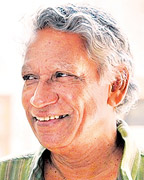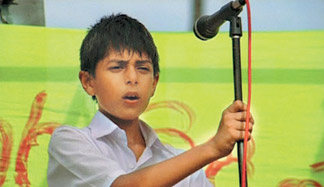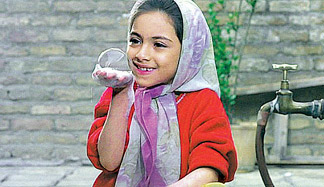|

Past forward
Ishara JAYAWARDANE
They reflect the grandeur of past decades and are footprints of the
developments of that the world of celluloid had conquered throughout the
years. A visual time travelling experience, these hits boasts of
abundance of talent and heard work that need to be remembered and
preserved as an example for future generations, Yet the sad fact is that
many of the award winning past movies are fast dying away before our
very eyes.
|

Professor Phang Lai Tee. Picture by Rukmal Gamage |
Senior Assistant Director at the Audio Visual Archives of the
National Archives of Singapore Professor Phang Lai Tee was in Sri Lanka
recently to speak at the Second Annual Lester James Peries Oration.
Prior to the event Professor Tee unfurled her ideas on her experiences
of archiving, challenges and the opportunities that Singapore has
experienced on the subject, with the Sri Lankan audience.
The Audio Visual Archives in Singapore started in 1996 and it was
under the recommendation of the advisory council of Culture and Arts
headed by the then Deputy Prime Minister Cheong, who later became the
first elected president.
“He recommended that there should be a National Heritage collection
and it should be strengthened to cover sound and moving images. And by
that it also covers films,” Professor Tee explained.
She also added that the National Archives of Singapore has a
responsibility to collect and preserve audio visual archives that are
created by government agencies, private organizations as well as
individuals.
“The National Archives of Singapore has this broadened role that we
look into audio visual materials besides traditional paper and file
records. Increasingly even with the technological advancement we will
still preserve films as an archival medium. We preserve a lot of records
and films like microfilm. Film is a very special medium. It has this
emotive appeal to the audience. It has a special quality sometimes no
other medium can evoke,” she said.
In terms of Audio Visual Archives it does not just encompass film.
There are also video and audio recordings such as those that are
produced by broadcasting agencies. The National Archives of Singapore
has a very close relationship with the broadcasting organizations in
preserving audio visual records that are of national and historical
significance.
“We get together in appraising and selecting those that are of long
term value to Singapore. For example, news and current affairs
programmes, documentaries, stories told in the past by story tellers.
Today they have a special social significance in Singapore,” she said.
The National Archives of Singapore partners the Asian Film Archives, a
non governmental organization which has been set up to preserve
Singapore and Asian movies and to promote awareness and education.
“The role of the National Archives is to help to do the storage and
proper environmental control in the keeping of the films. The Asian Film
Archives are helping to promote, conduct studies and to encourage
scholarship in the study of films that is related to Singapore and Asia.
Because the National Archives is limited in resources such a partnership
is very good. Our strength is in preservation and in properly keeping
and mitigating the costs for the future. Asian Film Archives are good at
organizing programmes, workshops and discussions,” professor Tee noted.
Commenting on young film makers, she said that today, when they create
films, they create it as a social commentary on society. These films
have their significance over time. In time to come these are like social
commentaries on the society today.
“I am a chemist by profession and I learnt about archiving on the job
and through my colleagues who have been working in this area for a long
time. We do have technical colleagues who are more experienced in the TV
programme industry.
They are sent for exchange programmes and training classes overseas
to learn about film archiving and audio visual archiving. We organize
workshops in Singapore on our own. In 2008 we organized ASEAN COCI
workshop, where we invited specialists from different countries to talk
about audio visual archiving; how to do it and the importance of
archiving. In February 2012, we worked together with the French Embassy
in organizing a workshop on digital preservation of audio visual
archiving. So in terms of archiving, we have advanced in terms of our
preservation approaches and technique,” she expressed.
Speaking on the prospect of an exchange programme between the
National Archives of Sri Lanka and the National Archives of Singapore,
she said that the two countries share many similar approaches in the way
they handle archival material.
“As a chemist I first got into conservation in the museums. The
museum and archives are under the same parallel organization called the
National Heritage Board of Singapore. I have experience in broadcast
management, archives services, electronic management and corporate
services. I have been with the National Heritage Board for more than 15
years and the National Archives about that same period. For the last
five years I have been in audio visual archiving,” she said.
Lanka’s first Tamil film
K S Sivakumaran
The local Tamil film industry is almost dead. It’s natural because of
several obvious factors: limited audience, inability to match the
technical advancement of films produced in Kodambaakam in Chennai (Kollywood),
audience is attuned to and conditioned by the formulas of the Tamil
films produced across the Palk Straits, regional dialects not understood
by all the people and so on.

Dharmasena Pathiraja |

Chandran Rutnam |

Prasanna Vithanage |
However, there is hope in the making of short films by many
youngsters. Film directors belonging to the Sinhala community have to
some extent tried to show slices of lifestyle of the northern people in
their Sinhala language films.
The names of Dharmasena Pathiraja, Gamini Fonseka, Sunil Ariyaratne,
Chandran Rutnam, Prasanna Vithanage, Bennet Rathnayake and recently
Asoka Handagama come to mind.
Ironically the first Tamil film in Lanka was made by a person named
Henry Ariyawansa. Some said that he was a Malayalee. I am not sure of
his mother tongue or ethnicity.
The title of the film was ‘Samuthayam’ (meaning Society)). It was
made in 16MM, but it was not distributed in the theatres but shown to a
closed-circuit audience. However strictly-speaking the first Tamil film
made in Lanka on 35MM was ‘Thottakkari’ (Estate Woman). It was directed
by Krishnakumar who was also of Malayalam origin.
Here is a brief note on it remembering what I spoke in the ‘Arts
Magazine’ programme in the English Service of then Radio Ceylon several
decades ago.
When compared with average and immature Kollywood Tamil films of
yesteryears, ‘Thoattakari’ indicated a promising attempt at film-making.
Though not innovating in its experimentation, it had some positive
aspect in spotlighting a social issue.
It was a black and white film shot in 16 MM. It brought to our notice
that there were competent film technicians in our country too in the
1960s. But the film did not have an organic structure. It gave the
impression that the cinematographer and the director were just playing
with their tools of making a film.
Considering the inadequate facilities and guidance and the use of
updated techniques, the short exercise could be considered a bold
attempt at the time when Lankan Cinema as a whole was in its formative
stages.
The glaring haphazardness in the making of ‘Thoatakari’ was that the
producer and director did not understand the basics of a film and merely
thought of capturing in camera a local Tamil stage drama. This was
excusable because lot of people then did not understand that cinema is
different from drama as a form of art. And conversely at that time the
local Tamil drama too was substituting Tamil films of India.
‘Thoatakari’ was only partially rooted in a Lankan Tamil idiom. The
estate people’s lives and their manner of speaking, customs etc were
really a transportation of the South Indian milieu. So one could not
call a truly Lankan film with its uniqueness.
[email protected]
Films for social integration
Ruwini Jayawardana

Children of Heaven |

Goodbye Lenin |

Vidhu |
The National Languages and Social Integration Ministry together with
the National Film Corporation (NFC) and GIZ will launch a film festival
to commemorate social integration week from July 16 to 22. Seven films
will unspool on the NFC cinema hall at 5.30 pm each day.
‘Sarungalaya’, the yesteryear Sinhala hit will be screened on July 16
with Tamil subtitles. The film embodies the themes of caste issues and
ethnic conflict. A Tamil public official is transferred to Colombo from
Jaffna. He is liberal and opposed to nationalism. The film unfurls in
flashbacks as he begins a romantic liaison with a young Sinhala woman.
Meanwhile his sister begins a relationship with a young man from a low
caste. She commits suicide because her family does not give their
consent to the liaison. Struck by the tragedy, the Tamil official
ventures to Colombo in search of greener pastures but gets caught in an
ethnic conflict. The Tamil film ‘Ponmani’ will be screened on July 17
with Sinhala subtitles. The protagonist of the tale, Ponmani, is the
youngest daughter in a family from the highest caste in the Tamil
society. However her family has fallen on hard times and cannot even
cover the debts they own for her eldest sister’s marriage. They are not
in a state to find dowries for Ponmani and the second daughter of the
family. When Ponmani takes matters into her own hands and elopes with a
boy from the lower fisherman caste, the family honour is at stake. The
film takes a feminist analysis of the society.
‘Goodbye Lenis’, the German movie which will be screening on July 18,
is based on the backdrop of East Germany during 1989. Written by
Benjamin Stello, the movie concerns the protest towards the regime and
how a mother who awakens from a coma and finds herself about in a time
when the world has changed a lot from the time that she knew.
Asoka Handagama’s ‘Vidhu’ revolves around the themes of education,
children and socio-economic differences. It will be screened on July 19
with English subtitles. The popular Iranian film ‘Children of Heaven’
which embodies similar themes to ‘Vidhu’, will unfurl on July 20. French
film ‘The Untouchables’ will be screening on July 21. It relates the
friendship between two unlikely individuals: a wealthy disabled person
and a youth of Senegalese descendant.
The film week comes to a close with the English movie ‘Invictus’ on
July 22. This movie focuses on race, integration and unity. It is an
aspiring story of how Nelson Mandela joined forces with the captain of
South Africa’s rugby team to help unite their country.
“These movies reflect that outward integration is not enough to unite
all beings. We need to bond through our hearts,” said National Languages
and Social Integration Ministry advisor Sankajaya Nanayakkara. He also
said that this is one of the events which Minister Vasudeva Nanayakkara
has initiated for the social integration week.
Anagarika Dharmapala’s biography to take over the screen
Anagarika Dharmapala is an evergreen figure in Sri Lankan history.
One of the founding contributors to the national revival, Dharmapala was
also a pioneer in the revival of Buddhism in India after it had been
virtually extinct there for several centuries. He was the first Buddhist
in modern times to preach the Dharma in three continents: Asia, North
America, and Europe. He was also a major reformer and revivalist of Sri
Lankan Buddhism.
Now his biography will be made into a film by director Ranjan
Prasanna. This will be Prasanna’s debut cinema venture as a director. He
has many years of experience working as the assistant director for
productions like ‘Julia’, ‘Ira Handa Yata’, ‘Ekamath Rka Rateka’ and ‘Sinhavalokanaya’.
His teledrama ‘Sihina Puraya’ is telecasting on Sirasa TV these days.
Tissa Athaley is the producer of Prasanna’s film. Sisira
Hettiarachchi is the production manager. The script is by Saman Weeraman.
RJ
‘Kusa Paba’ breaks revenue records
Professor Sunil Ariyaratne’s film ‘Kusa Paba’ made a record-breaking
revenue of Rs 202, 164, 021.17 in its screening period from January 26
to May 31, EAP Cinemas report. This is the highest revenue record in the
65-year local cinema history.
According EAP Cinemas, the number of viewers had been 1,587,299.
‘Kusa Paba’ is also the film with the highest one-day revenue record (Rs
5,651,402.69) and two-day revenue record (Rs 10,241,850.85). It is the
first Sinhala film ubiquitously screened in 54 cinema halls. |



